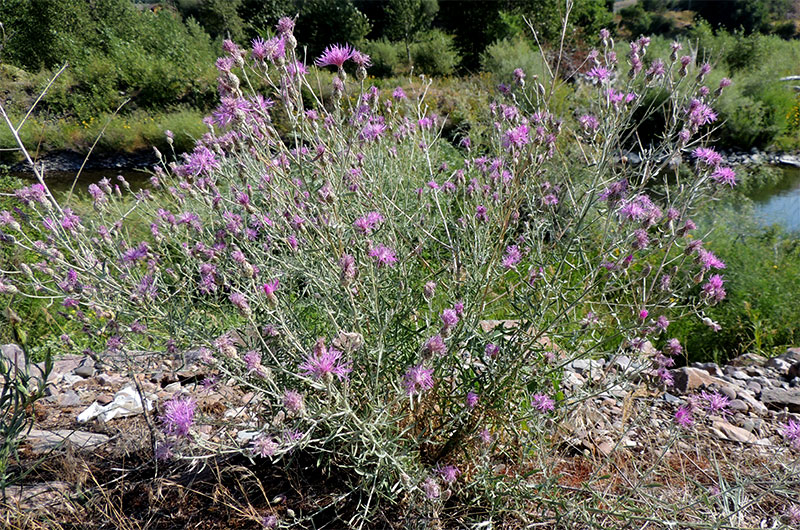by Sarah Treanor Bois, Director of Research & Education for the Linda Loring Nature Foundation

Native to central Europe, spotted knapweed was likely introduced to North America as a contaminant in alfalfa seed. It was first recorded in the U.S. in Washington State in the late 1800s. By 2000, it was reported from 45 of the 50 states and considered a “nuisance species” in most of those states.
Its name is derived from the black margins of the flower bract tips which give the flower heads a spotted look. The dusky green leaves are highly divided and persist as basal rosettes when not in flower. The flowering part of the plant only shoots up (bolts) in the early summer to reproduce. Individual plants may produce up to 140,000 seeds per square meter. Most seeds are shed immediately after reaching maturity. That means, once these plants go to seed, try not to mow and spread further!
Another aspect to caution readers about is that the sap of spotted knapweed can cause skin irritation. As a precaution, anyone pulling or managing spotted knapweed should wear protective gloves. If you have worked with knapweed, you should wash your hands and exposed skin with soap and water following contact with this plant.
Aside from skim irritation, what harm can this plant do? This seemingly delicate plant is known for its alllelopathic qualities. That means that it exudes toxic chemicals through its roots, killing or stunting the growth of neighboring plants. It is unpalatable to many grazers and browsers, which is why the western US has had such economic problems in the rangelands.
On Nantucket, our concerns mainly lie with the sandplain grasslands and heathlands which are particularly vulnerable to a spotted knapweed invasion. Many of Nantucket’s rare and threatened species are grassland specialists thriving in nutrient-poor, sandy soils. Because spotted knapweed absorbs large amounts of water via its large taproot, when it replaces native grasses, soil erosion and surface runoff are increased, depleting precious soil resources.
What is Nantucket doing about this plant? The Nantucket Invasive Plant Species Committee (IPSC) has been targeting hand-removal of this species along roads and paths adjacent to conservation lands along Eel Point Road, Madaket Road, and the south coast. We’ve been working hard to tackle this plant prior to seeding since this plant can produce an estimated 5,000 seeds per square foot.
Seeds can remain viable in the soil for up to eight years, so, while removal is critical, it is also important to monitor the area for new sprouts each year. What can you do? If you see something, say something. Reports of this plant can be sent to me, Dr. Sarah Bois, at the Linda Loring Nature Foundation (stbois@llnf.org) or Kelly Omand of the Nantucket Conservation Foundation (komand@nantucketconservation.org). But the best thing you can do is to remove the plants yourself!
Here are some tips for removing the plant at home:
- Have the right tool for the job. Fortunately for us on Nantucket, sandy soils make pulling and digging long roots a little easier. We’ve found that the specialized weed digger tool with a long blade works best, but most heavy duty digging tools will do.
- Wear gloves! The noxious chemicals produced by spotted knapweed can irritate the skin of humans and can sometimes cause migraines.
- Pull plants during their bloom period and before they’ve gone to seed. They will need to be bagged and disposed of in household trash. You don’t want any of those invasives getting in to the compost!
- Try to get as much of the root as possible. Pieces of root left in the ground will sprout the following year.
- Join the Nantucket Invasive Plant Species Committee (IPSC) in our group pulling events! What’s better than a coffee clutch? An invasive plant clutch! Join us for one of our organized pulls and we’ll help you learn to ID the plant, best methods for removal, and you’ll be contributing to the preservation of some of our island’s finest native habitats. For details contact me at the email above.


